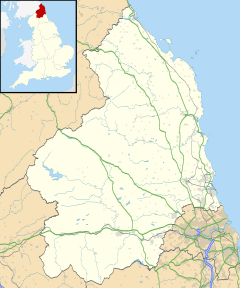Kirkharle facts for kids
Quick facts for kids Kirkharle |
|
|---|---|
 Kirkharle |
|
| OS grid reference | NZ015825 |
| Civil parish |
|
| Unitary authority |
|
| Ceremonial county | |
| Region | |
| Country | England |
| Sovereign state | United Kingdom |
| Post town | MORPETH |
| Postcode district | NE61 |
| Dialling code | 01830 |
| Police | Northumbria |
| Fire | Northumberland |
| Ambulance | North East |
| EU Parliament | North East England |
| UK Parliament |
|
Kirkharle is a small village in Northumberland, Northern England. It is located about 12 miles west of the town of Morpeth. The village is famous as the birthplace of Lancelot 'Capability' Brown. He was a very well-known landscape gardener in Britain during the 1700s.
Contents
Exploring Kirkharle
What is Kirkharle?
Kirkharle is a quiet village in the beautiful countryside of Northumberland. It sits near where the A696 and B6342 roads meet. In 1951, only 69 people lived in the area.
A Look at Kirkharle's Past
For a while, Kirkharle was its own civil parish. However, on April 1, 1958, it joined with the nearby parish of Kirkwhelpington. This means it became part of a larger local area.
Famous Buildings and Places
Kirkharle has some interesting old buildings and sites.
Kirkharle Hall and St Wilfrid's Church
Kirkharle Hall was once a large country house. It was the home of the Loraine family for many years. Today, it is much smaller and used as a farmhouse. The church on the estate is called St Wilfrid's Church. It is a very old building, with most of it built in 1336. It is considered a Grade 1 listed building, which means it is very important historically.
Little Harle Tower
About a mile north of Kirkharle, you can find Little Harle Tower. This building is an 18th and 19th-century mansion. It includes a much older part: a pele tower from the 15th or 16th century. Pele towers were small fortified houses built to protect against raids.
Kirkharle Courtyard
Today, Kirkharle Courtyard is a special Visitor Centre. It focuses on the life and work of Capability Brown. Visitors can learn all about him and his amazing landscape designs.
The Story of Kirkharle's Name
Before it was called Kirkharle, the village was simply known as Herle. This name was recorded in 1177. Herle comes from old English words. It might mean "Herela's Grove" or "temple-grove." A "temple-grove" would have been a place of worship for the Angles before Christianity arrived. Later, the word kirk (meaning church) was added to the name. This is why it became Kirkharle.
St Wilfrid's Church Today
The current church, dedicated to St Wilfrid, was built in the 1300s. The Loraine family became owners of the manor in the 14th century through marriage. They even took their name "Loraine" from the village of Harle. In 1836, the Loraine family sold Kirkharle. The main house was then taken down.
Lancelot 'Capability' Brown: A Landscape Legend
Kirkharle's most famous person is Capability Brown. He was a very important landscape gardener.
Who Was Capability Brown?
Lancelot 'Capability' Brown was born in Kirkharle. He was baptised at St Wilfrid's Church on August 30, 1716. We don't know his exact birthdate. He was one of six children. His father, William Brown, was a farmer. His mother, Ursula, also worked at the big house on the Kirkharle estate.
His Early Life and Work
Young Lancelot went to school in nearby Cambo until he was 16. In 1732, he started working at the Kirkharle estate. Here, he learned many skills in gardening, planting, and improving land. He left in 1739 to continue his career.
Sir William Loraine, who owned the estate, inherited it in 1755. When he grew up, Brown created a design plan for him. This plan was to change the old formal gardens into a more natural-looking landscape. This probably happened around 1770. Brown's plan included planting single trees and tree belts. He also designed a winding lake and a new way to approach the house. However, only parts of his plan were actually built. The lake was not created at that time.
Bringing Brown's Vision Back to Life
Brown's original plan was found again in 1980 by the current owners of Kirkharle, John and Kitty Anderson. They decided to restore the park, which is a Grade II-listed site. They wanted to bring Brown's vision for the landscape to life. This included creating the lake he had proposed.
It was not possible to make the lake as one single body of water. This is because the A696 road, built in 1883, now cuts across the park. So, in 2009, two winding lakes were created instead. Hundreds of new trees were also planted. In 2016, a waterfall (called a cascade) was added. Brown often used cascades to make two lakes look like one. This was part of the Capability Brown Festival, celebrating 300 years since his birth. The water started flowing through the cascade on August 30, 2016. This was the 300th anniversary of Brown's baptism at St Wilfrid's Church.
Today, you can visit the lake, the grounds, and St Wilfrid's church. They are all part of the Kirkharle Courtyard Visitor Centre.
Other Interesting People
Charles Loraine Smith was an artist and fox hunter. He was born into the Loraine family. He later adopted the name Smith when he was a boy.


